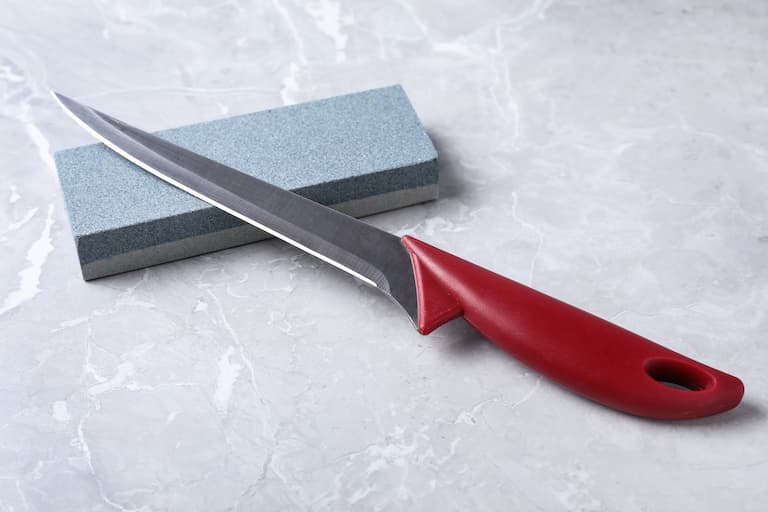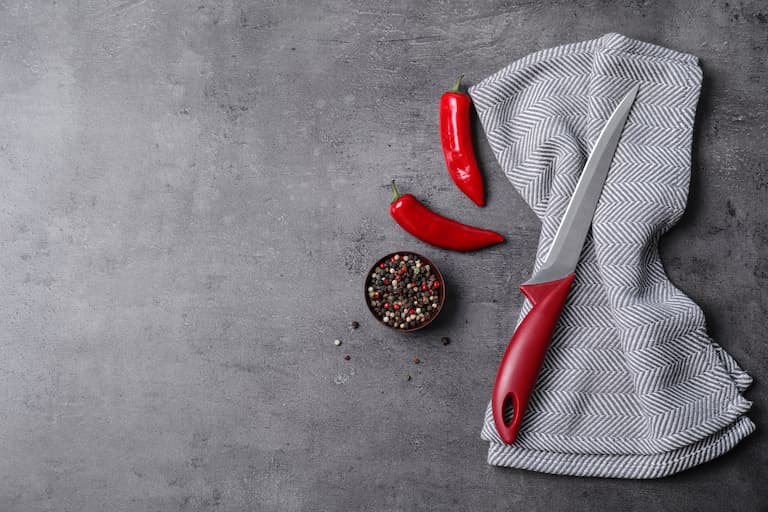Your Cart is Empty
Free US Shipping
Free US Shipping

In just about any home environment, we have designated areas. The bedroom is for sleeping, the living room, and relaxing. In the kitchen, we cook. Knives make up an essential part of food preparation. Today let's examine the differences between the boning knife and the cleaver.
The boning knife and the cleaver are different in both appearance and usage. Boning knives are small and are used to cut raw meat away from the bone. Cleavers chop through raw meat and bone with a large, rectangular blade.
As you read through this article, you will get to know both knives much better. First, let's take a quick look at the terminology used for each part of a knife.
It's a pretty safe bet that you use a knife every day (for prim and proper reasons, I hope). However, you may not be familiar with how the parts of these cutting instruments are named. Don't worry—I've got you covered.
First, we have the butt, which is the rounded end at the bottom of part number two, the handle. Inside the handle is what's called a tang. Don't get thirsty—it's not a drink. The tang connects the blade to the handle, normally through the use of rivets.
Next comes the bolster. This is a short, "demilitarized" zone between the handle and the blade. Its purpose is twofold: It balances the knife and keeps the user's digits from accidentally becoming part of the meal. Beyond the bolster comes the blade, which comprises a spine, edge, tip, and point.
I feel it's essential to get to know your knives before putting them to use. More knowledge almost always leads to more confidence and comfort. And while I wish for you to maintain a healthy respect for cutting tools, I don't want you to be intimidated.
Now it's time to take an up-close look at the boning knife. From there, we'll move on to the cleaver.
It can be said that the boning knife's name is somewhat misleading. It's not meant to actually cut through bones, after all. But one glance at the intransitive verb definition of "bone" clears everything up: "To remove the bones from".
Herein lies the true purpose of a boning knife. It is a slender, precise instrument used for cutting raw meat away from the bone. No kitchen or meat department is complete without a good boning knife. They come in many designs and price ranges. Having said that, they needn't be fancy at all.
Your typical boning knife is about 6 inches (15.24 cm) long. It looks similar to a small cutlass, having a slim, flexible blade that curves gently upward to an extremely fine point. However, you don't use boning knives on a pirate ship (unless you happen to be the mess cook). Errol Flynn never carried one—at least, not to my knowledge.

If you're new to food preparation and haven't done a lot of precise cutting with your knives, I'm hoping this segment can help. First, count the fingers on your hands. Assuming they’re all there, that's how I want things to stay.
To use a boning knife, place the tip of the blade on the meat; start with a small incision, then draw the rest of the blade into the meat, using sawing gestures to cut it away from the bone.
I used to work in a grocery store meat department, and this is how one of the butchers trained me. As for the handling of the knife, he showed me how to wrap three fingers around the handle and cut with my index finger on top of the blade. "Think of the blade," he said, "as an extension of that finger."
Most boning knives have flexible blades. These blades can actually be bent this way and that to maneuver around pesky bone protrusions. Getting used to this flexibility can take a little practice but don't let it frustrate you. For less resilient meats, such as beef, a stiff-bladed boning knife is often a better choice.
To see a boning knife in action, have a look at chef Norman Weinstein's video here:
The boning knife is also designed to be pinpoint accurate. Because it is so precise, chefs just like you can sometimes use it for more than just carving meat. For instance, a boning knife can actually cut the skin off of fish filets. This same versatile piece of equipment also works for slicing fruits and vegetables.
I do feel the need to stress that there are other knives designed for these purposes. Reach for a boning knife only if nothing better happens to be available.
And please...leave the swashbuckling to the pirates.

The boning knife is almost a necessity for any kitchen. Still, it doesn't actually cut through bone—or rather, it isn't designed to. But then you're not supposed to put a boat on a runway, or an airplane in the water. So when it comes time to cut bone, where do we turn?
There are a few knives that can cut through bone. Other than the cleaver, the most common knife used for cutting through bone is the standard butcher knife.
In fact, the terms "butcher knife" and "cleaver" are often interchanged by casual users. This in no way dismisses the notable differences between the two.
A butcher knife can be 8 to 12 inches (20.32 to 30.48 cm) in total length. The blade is long and somewhat unnerving to behold, with a concave spine that arcs to a lethal point. Butcher knives are used in chef's kitchens worldwide, but also make great companions for hunters in the wild.
Because of their sleek design, butcher knives are also known, in certain circles, as scimitar knives.
Other knives that can cut through bone include:
Now let's move on to examine our bone-cutting knife for the day: the cleaver.
Ah, the cleaver! Now we're getting into serious terrain. To wield a cleaver is to instantly feel all inadequacies with self-confidence vanish. If you don't believe me, go outside with a cleaver in your hand and witness the terrified obeisance of puny neighborhood underlings.

No, don't do that. In all seriousness, the cleaver is highly useful in the kitchen, so long as you afford it a great deal of respect (this goes for all knives, but we may double down on the intimidating cleaver).
As mentioned, the cleaver is used to cut through both raw meat and bone. Some people liken it to a hatchet in that the blade has a broad, blunt face that's attached to a thick handle. The spine of the blade may be concave, convex, or straight.
Unlike boning knives, cleavers are not designed to saw (though they slice just fine—more on that later). Rather, the user chops downward at the meat, hacking through bone and cartilage. The blade is made of a softer metal that can withstand heavy impact without being damaged.
Much of a cleaver's effectiveness correlates to how hard the wielder can swing. This fact places it among the more dangerous examples of kitchen equipment, though so long as you're a careful learner, you will deeply appreciate having one on the knife rack.
Let's examine the safe, effective way to use a cleaver.
Both butchers and chefs use cleavers. One goes about business a bit differently than the other, but for the sake of neatness, I will confine my answer to this:
To use a cleaver, raise your arm over the meat, bending the elbow; chop downward, being sure to let the wrist flick slightly. Chop in harmony with the weight of the cleaver but let the weight do most of the work.
To watch someone use a cleaver certainly makes the whole operation look dangerous. The colossal blade is raised high, and sometimes makes a whooshing sound just before it whacks into the meat. The thing to remember is to keep your free hand at a safe distance. Indeed, as you chop, keep everything at a safe distance.
Here is a short video of a cleaver in action:
If you must hold the meat, keep the tips of your fingers bent inward. I cannot stress this caveat enough. Every professional butcher you meet will tell you to do the same.
I've seen butchers chop meat with their fingers mere inches away from the blade. That kind of confidence comes only with practice, so please, if you're new to the cleaver, don't overwield. Get to know the blade and make sure the two of you remain on friendly terms.

Like other knives, the cleaver can be something of a utility player on the field. This is only when the proper cutlery is unavailable. In a pinch, you can use your cleaver for:
Cleavers make slicing a breeze. Just hold the meat with your free hand (fingers bent in). Using horizontal cuts, the edge of your cleaver will make quick work of things like skinless chicken and boneless cuts of beef or pork.
For mincing, hold the cleaver handle in your fist, then place your palm on the spine of the blade. Press down on the meat in quick little cuts, moving the edge sideways after each cut. This will get you a nice, even pile of minced meat.
To tenderize meat, you need to turn the cleaver upside-down. Then merely tap the blade's spine over the meat, using a criss-cross pattern. It's surprisingly effective, though admittedly not as much so as a traditional tenderizer.
Having a cleaver on your knife rack needn't frighten guests away from your kitchen. It is a very useful knife for preparing large sections of meat to be cut more intricately. The cleaver is a friendly bully. That is to say, tough on the bones while always ready to follow your every command.
Now, I don’t wish to pit these two knives against each other. This isn’t Rafael Nadal vs. Roger Federer. However, the boning knife and the cleaver are used for very different purposes. It is prudent to understand their roles. Let’s break it all down to simple terms.
The boning knife:
The cleaver:
The task at hand is going to dictate strongly which knife you reach for. Please don’t approach a classy group of dinner guests with a cleaver on your plate (especially on Halloween night); and please, don’t go hacking away at raw meat with a boning knife.
Additionally, there are specific techniques associated with each knife that need to be taken into account.
During food preparation, it's crucial to have proper equipment at your disposal. The boning knife, with its flexible blade and ultra-fine point, makes cutting meat away from the bone—and around the bone—a piece of cake (I may as well stick with food here).
The cleaver is more of a hacking instrument to be used during the early stages of food preparation. It will cut through bone, cartilage, and meat, sometimes in a single chop. You can also use the cleaver for other tasks, such as slicing and mincing.